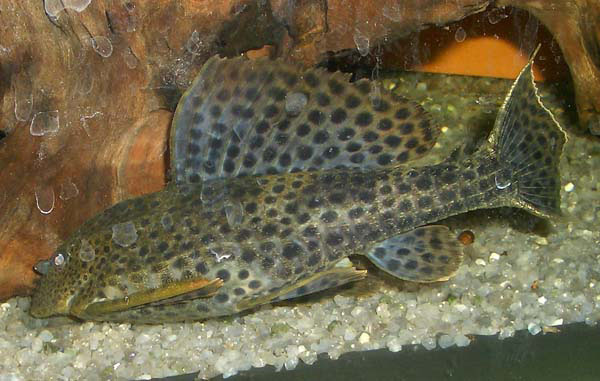| Loricariidae (Armored catfishes), subfamily: Hypostominae |
| 19.69 cm SL (male/unsexed) |
|
demersal; freshwater |
| South America: Rio Marañon, Rio Ucayali, Rio Caquetá and upper Rio Amazonas drainages of Colombia, Ecuador and Peru. |
|
Dorsal spines (total): 1-1; Dorsal soft rays (total): 11-12; Anal spines: 1-1; Anal soft rays: 4-4. Distinguished from all congeners except Pterygoplichthys punctatus by having the buccal papilla at least shallowly divided medially; and by having the lateral keel odontodes almost perpendicular to the plates (vs. sloped posteriorly) and by having the longest keel odontodes longer than the plates in the lateral-line row in the adult. Differs further Pterygoplichthys punctatus by having the buccal papilla partially divided in the adult (vs. fully divided at all ages), by having few spots on the abdomen and the bases of the fins (vs. many spots), and by having a wider body (SL/cleithral width 3.3-3.4 vs. 3.6-4.0). Can be further distinguished from Pterygoplichthys scrophus, Pterygoplichthys gibbiceps, Pterygoplichthys joselimaianus, Pterygoplichthys xinguensis, Pterygoplichthys lituratus, and Pterygoplichthys parnaibae by the absence of an elevated supraoccipital (vs. presence of an elevated supraoccipital forming an obvious crest); from Pterygoplichthys etentaculatus by having fewer than five hypertrophied odontodes on the cheek plates (vs. more than five); from Pterygoplichthys joselimaianus by having dark spots (vs. light spots); from Pterygoplichthys undecimalis and Pterygoplichthys zuliaensis by having a broadly round snout (vs. a narrow pointed snout); from Pterygoplichthys multiradiatus by usually having 11 dorsal-fin rays (occasionally 12 vs. 12-13); and from Pterygoplichthys anisitsi,
Pterygoplichthys disjunctivus, Pterygoplichthys multiradiatus, and Pterygoplichthys pardalis by having hypertrophied odontodes on the cheek plates of the adult (vs. hypertrophied cheek odontodes absent) (Ref. 75871). |
|
|
Least Concern (LC); Date assessed: 01 December 2020 Ref. (130435)
|
| harmless |
Source and more info: www.fishbase.org. For personal, classroom, and other internal use only. Not for publication.

